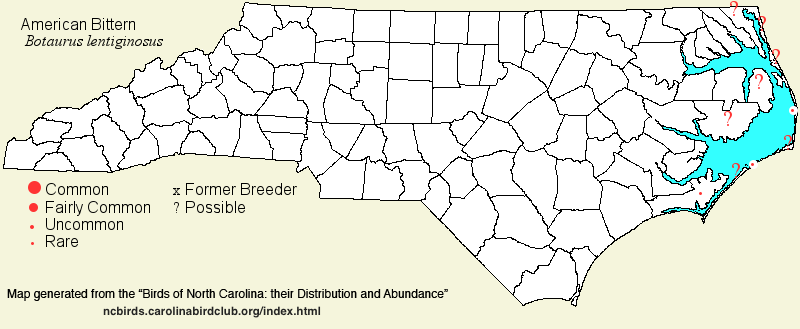 |  |
|
American Bittern - Botaurus lentiginosus ARDEIDAE Members: | Search Common: Search Scientific: |
|
|
|||||||
| General Comments | Both bittern species are secretive birds of marshes, sharing their home with rails and a very few other bird species. The American Bittern nests primarily in Canada and the northern half of the United States, but a few pairs do breed, likely annually, in our coastal freshwater marshes. However, it is far more often seen in migration and in winter, even though it is (on the whole) an uncommon species. In fact, numbers are declining across its range, owing to impacts to freshwater marshes and wet meadows. At all seasons it favors freshwater marshes, the more extensive and the more cattails the better; they also occur in slightly brackish marshes. | ||||||
| Breeding Status | Breeder | ||||||
| NC BRC List | Definitive | ||||||
| State Status | SR | ||||||
| U.S. Status | |||||||
| State Rank | S1B,S3N | ||||||
| Global Rank | G5 | ||||||
| Coastal Plain | Transient and winter resident, and sparse and poorly known breeder. Uncommon migrant in coastal and Tidewater marshes, less numerous in midwinter, though still uncommon, in this same region. Very rare to rare (and local) breeder, mostly in the Tidewater area in the northern half of the Coastal Plain; probably nests in many if not most summers at Mackay Island NWR, Mattamuskeet NWR, the Bodie-Pea Is. area, and Cedar Island NWR; casual or very rare as a known or possible breeder elsewhere along the southern and central coastal areas. Farther inland -- rare to very uncommon (and easily overlooked) migrant, and very rare to rare in midwinter; no known nesting records, but the species was reported in summer 2007 at a marsh near Goldsboro. Mainly Sep to early May; most numerous in Apr and early May, and again in Sep and Oct. Peak counts: 11, at a wetland mitigation site in southern Beaufort, 6 Apr 2016; 6, Occoneechee Neck (Northampton), 15 Apr 1972. | ||||||
| Piedmont | Transient and scarce winter visitor. Rare (to possibly uncommon, but easily overlooked) during migration; very rare during winter. No evidence of nesting in the province. Mainly mid-Aug to mid-May, most frequently noted in Apr and early May. Peak counts: 26, on the Durham spring count, 24 Apr 1983 (probably in marshes in the lakebed of Falls Lake, which was being filled at that time). Of note is an individual that has wintered at a pond at the Prairie Ridge Ecostation in Raleigh for four consecutive winters (2013-14, 2014-15, 2015-16, and 2016-17). | ||||||
| Mountains | Transient. Rare in Apr-May and again early Aug to mid-Nov; one record in Dec and two in Jan, but not known to overwinter. However, one seen at Jackson Park (Henderson) from 30 Jan - 26 Feb might well have overwintered. One photographed along a creek in Yancey on 30 Jun 2020 was quite unusual for midsummer, though there was no indication of breeding. Just as notable was one seen on 21 Jul 2024 at Hooper Lane (Henderson), also presumably a non-breeder. Most recent records are for the southern mountains, especially in Henderson and Transylvania. Peak count: two birds only. | ||||||
| Finding Tips |
Observers inland should look for bitterns during spring and fall migration at large marshes, generally along the margins of reservoirs. Your best bet in the state is probably at Bodie and Pea islands, where the birds may be seen around the fringes of the impoundments, or at times in flight over the ponds. This can sometimes be a difficult bird to find for your year list, unless you are willing to do some marsh wading at fresh or brackish marshes. Nonetheless, bitterns can at times be seen along roadside ditches near the coast, seemingly oblivious to passing cars! ** | ||||||
| Attribution | LeGrand[2025-05-08], LeGrand[2024-11-04], LeGrand[2022-04-26] | ||||||
| NC Map Map depicts all counties with a report (transient or resident) for the species. | Click on county for list of all known species. |
| NC Breeding Season Map Map depicts assumed breeding season abundance for the species. |  |